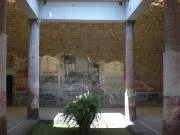A poet's impluvium
Today is World Poetry Day. On the Poetry Foundation’s website, a poetry novice describes her self-guided instruction in the genre. Memoirist Emily Gould read a random poem from the website each day for a month, then picked four favorites and read the books in which they were originally published. She writes:
It turns out that unless you make a concerted effort in the direction of reading poetry, poetry doesn’t just traipse into your mind by chance. You have to seek poetry out and, at least at first, you have force yourself to swallow it. Like a scratchy vitamin . . . . A poem requires full attention in a way that prose does not, and worse, a poem is much harder to like because every word matters. In a 5,000-word story or article, a reader will forgive or just not notice an off metaphor, unfunny joke, or annoying word. But one false note destroys a poem, or at least destroys its rapport with a reader.
She discovered that reading an author’s whole book of poetry not only is quick, but also may leave her with an entirely different impression from the single poem. She now turns to poetry as a break during her own writing work, as a mind-clearing alternative to the cluttering effect of checking Twitter, email, and "other sinkholes."
The New York Times points out that World Poetry Day coincides with the anniversary of Twitter, launched five years ago today by software designer Jack Dorsey. To mark the occasion, the “Week in Review” section has published four new poems of 140 characters or less. I especially smiled at Elizabeth Alexander’s “Teeny tiny poem,” and I learned a new vocabulary word, “impluvium.” The article also urges us to tweet our own poems using the hashtag #poetweet. Might be a good day for Twitter breaks after all.
I have two further recommendations regarding poetry: One, read poems aloud. Two, go to poetry readings.

